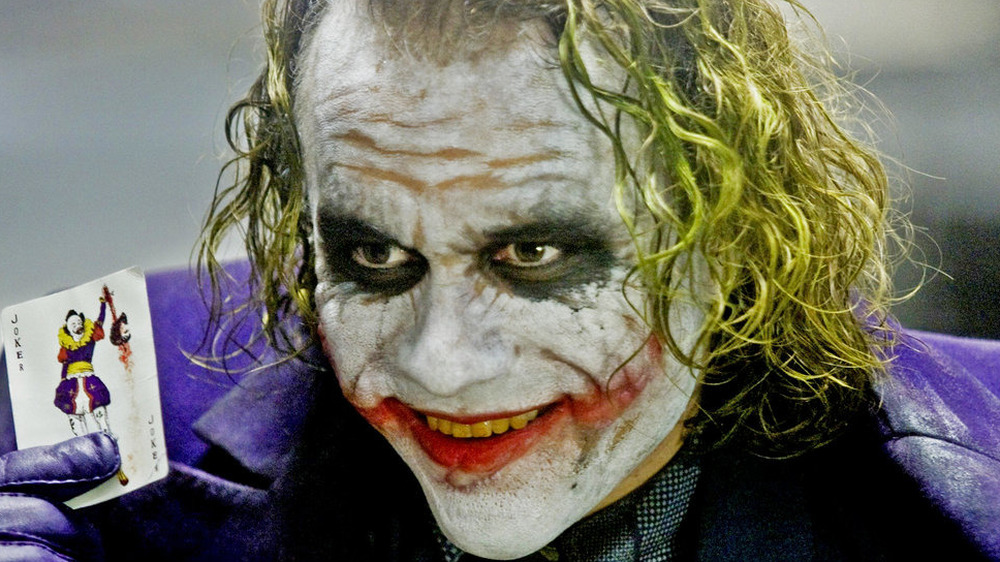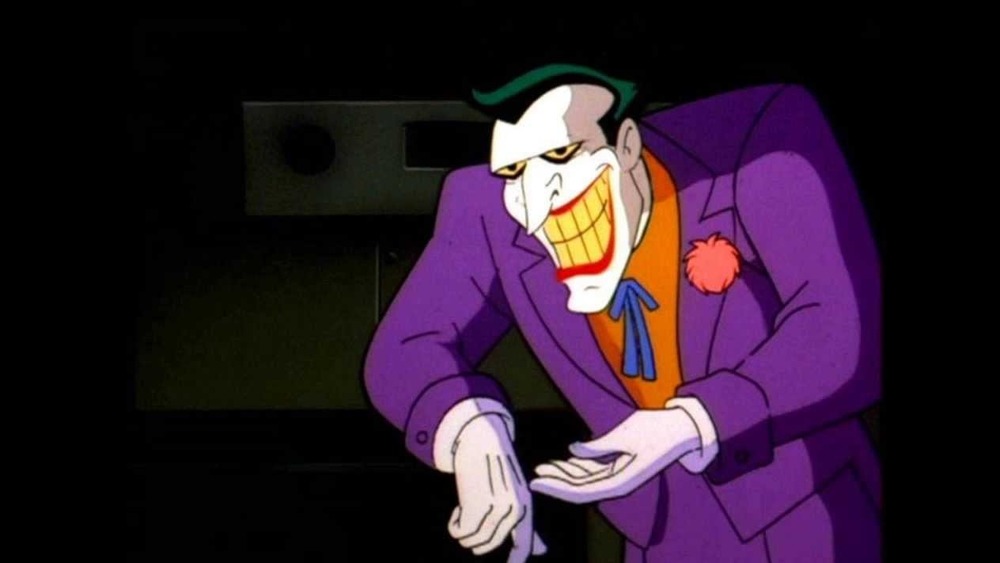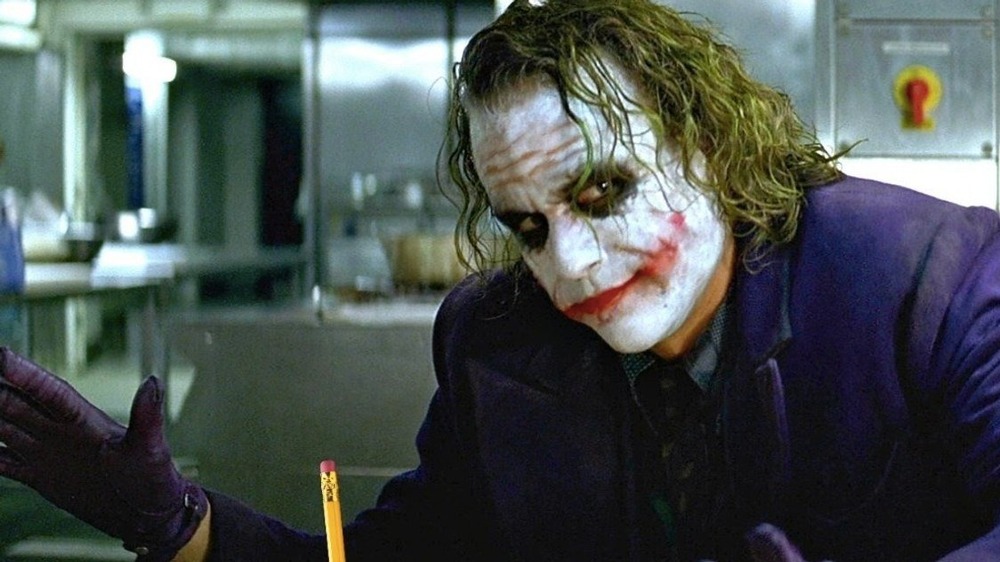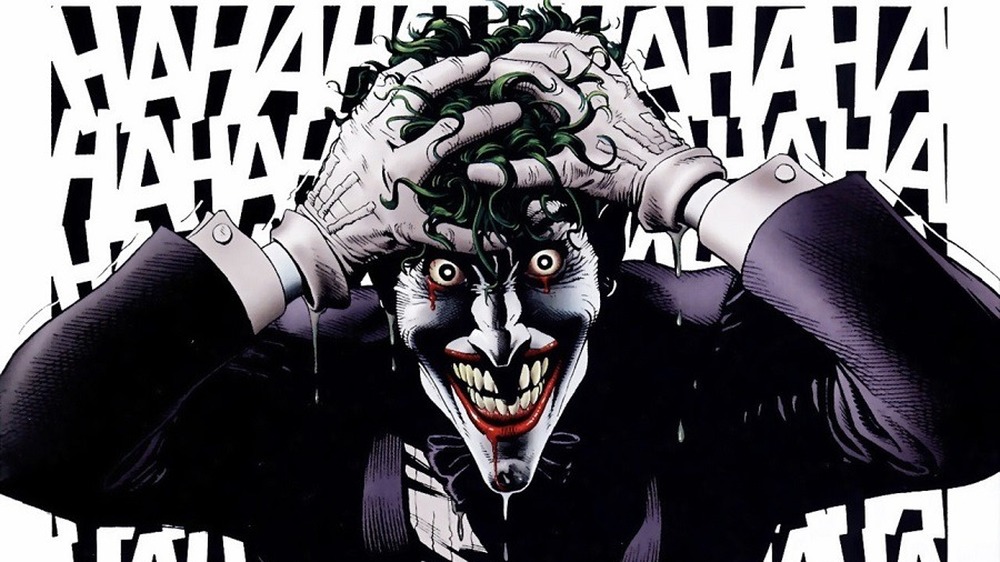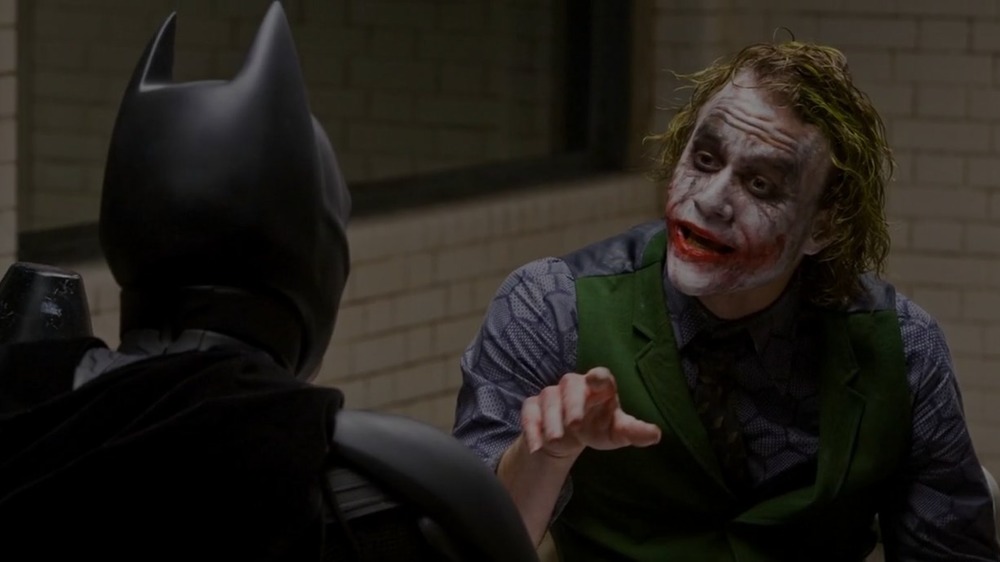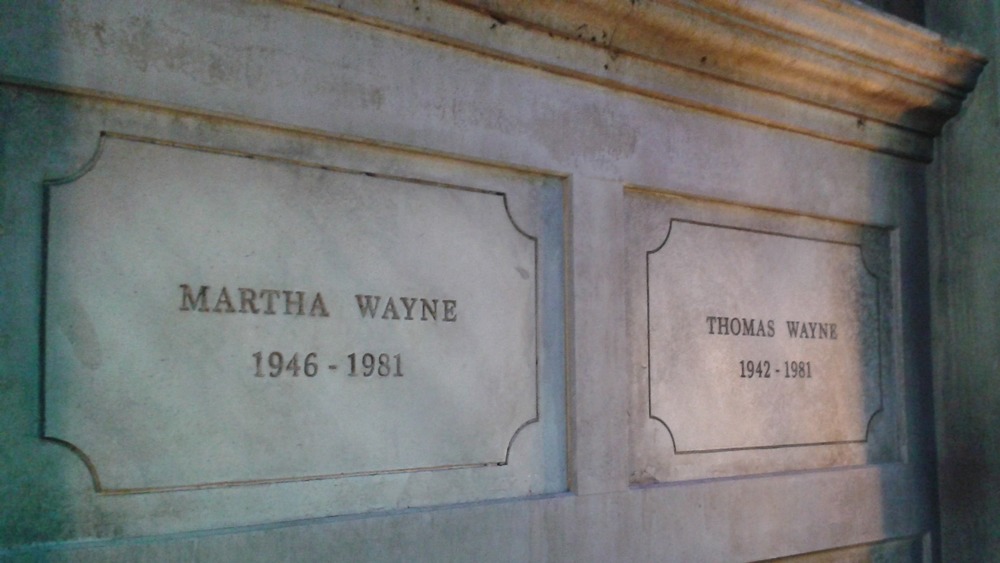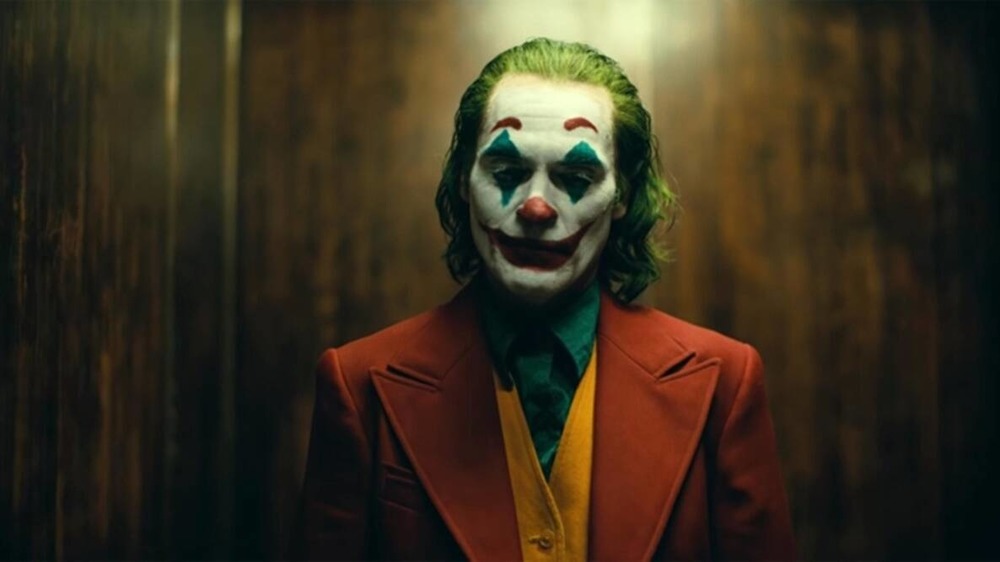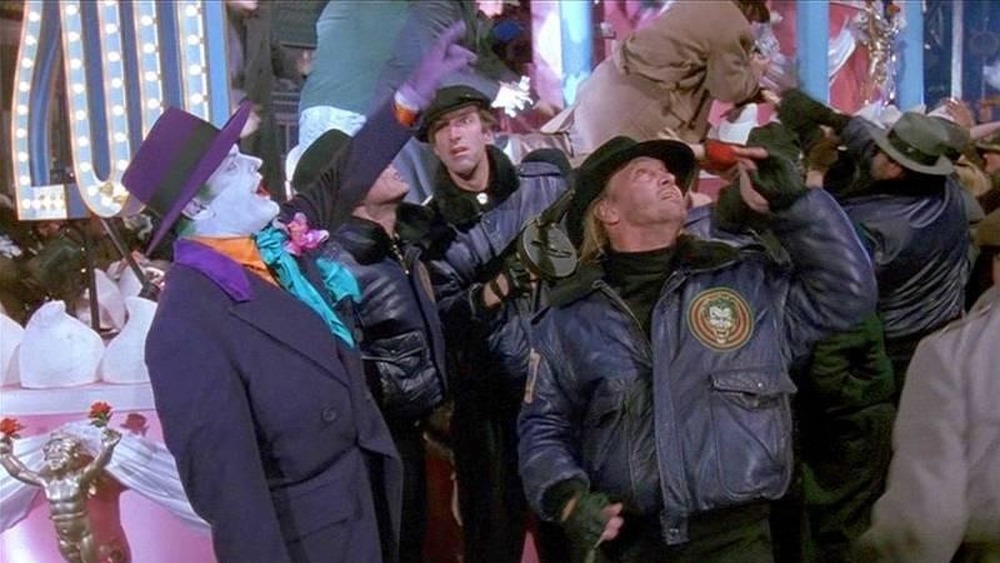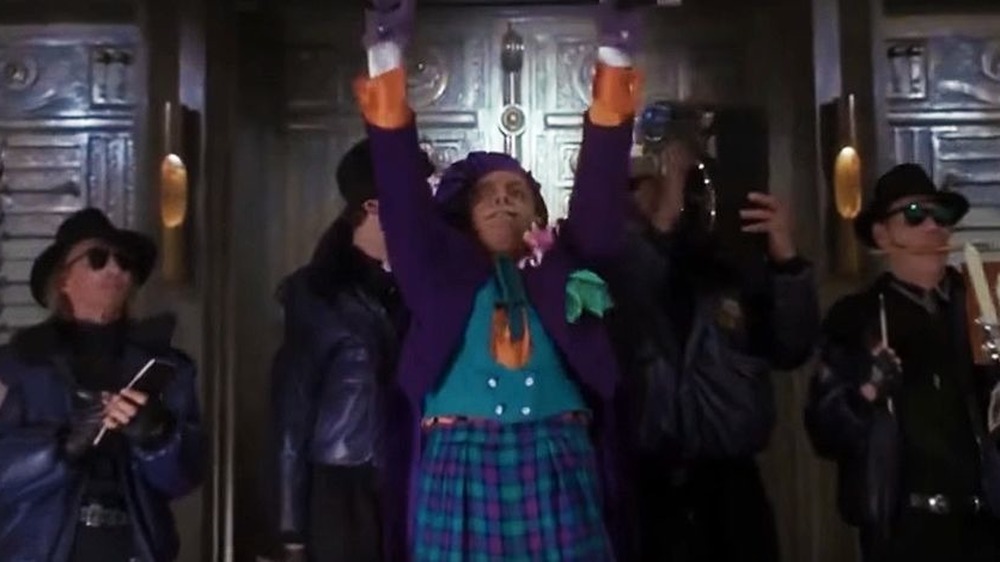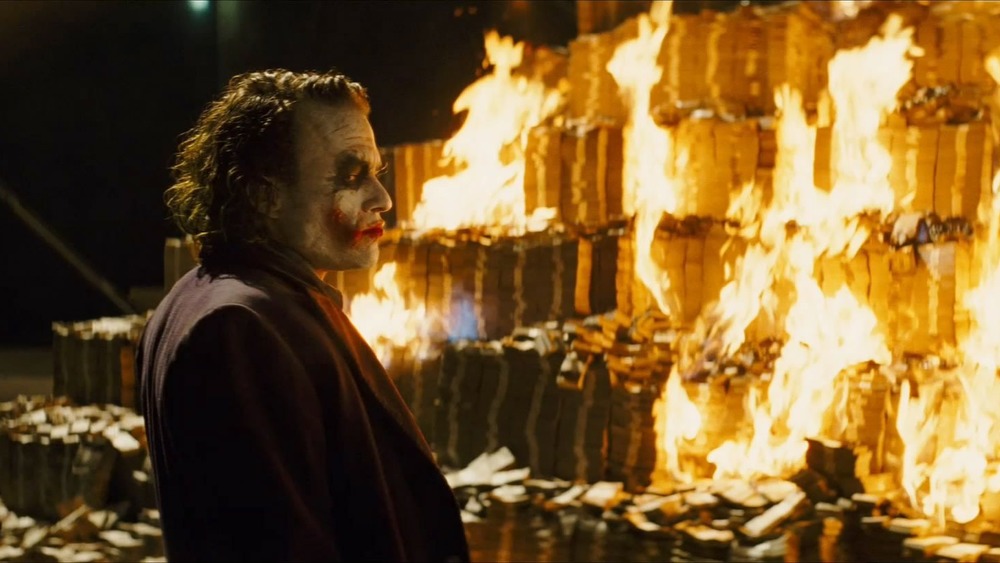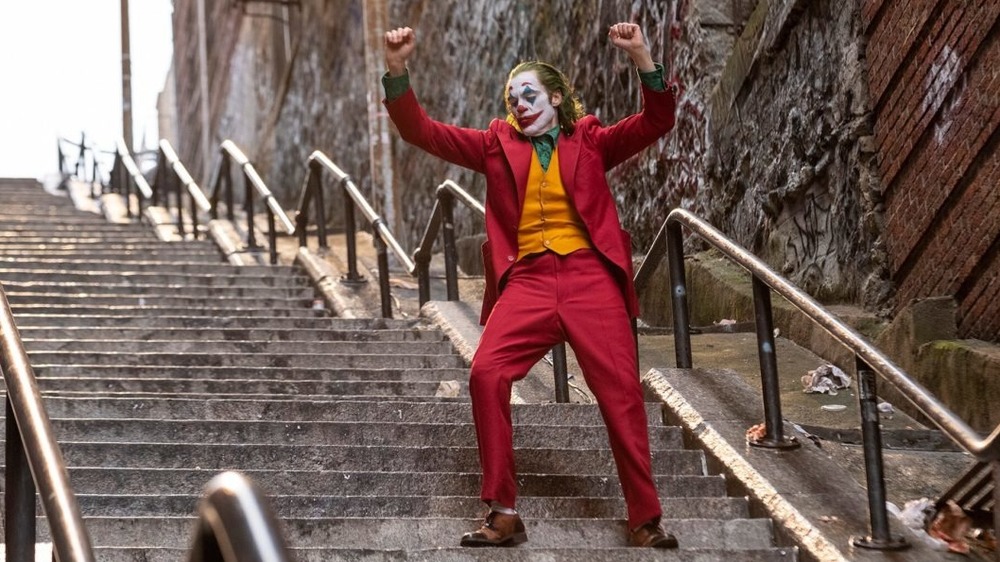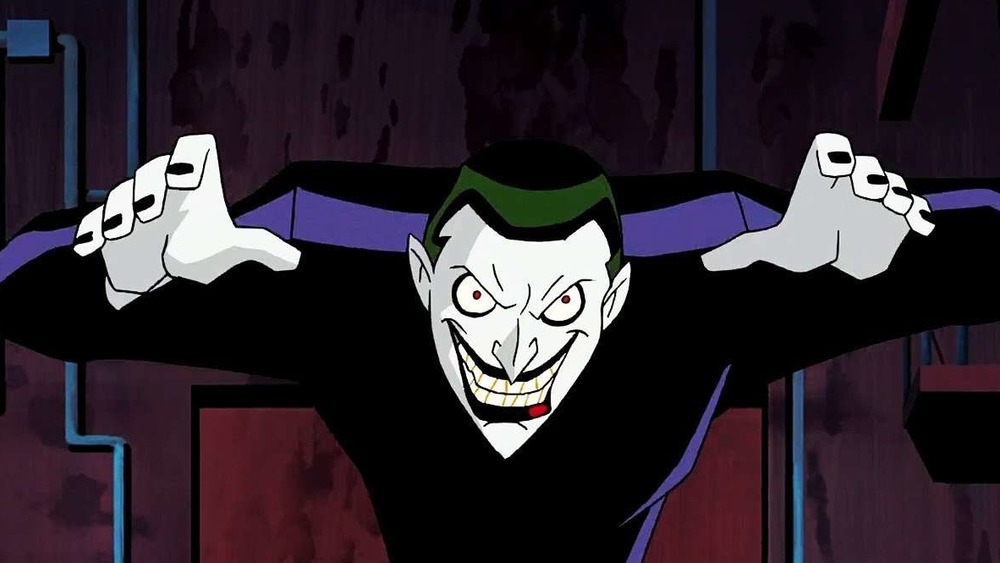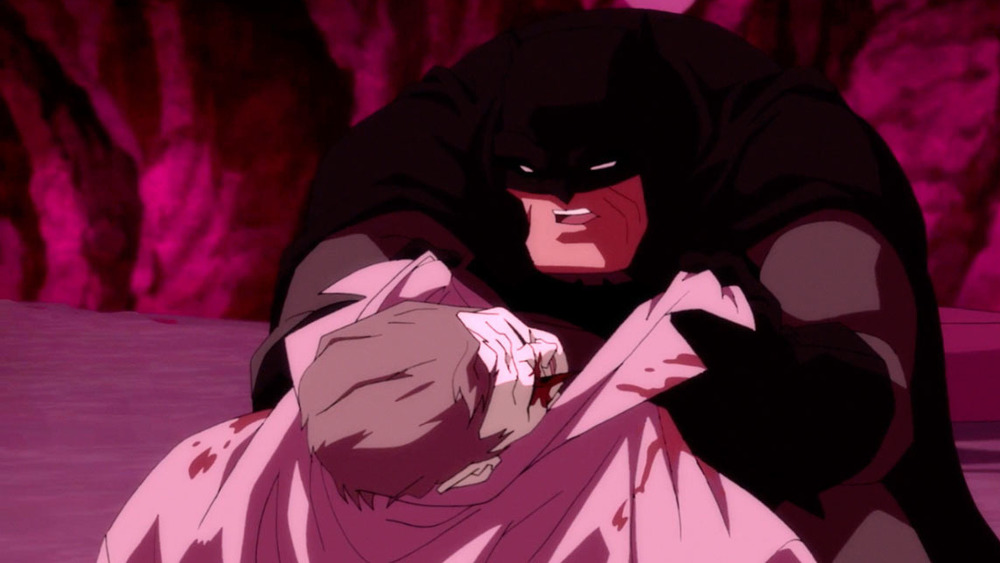Rules The Joker Has To Follow In Every Movie
When Zack Snyder released a new trailer for his cut of Justice League, fans went wild. For a number of those devotees, their excitement was linked directly to the confirmed presence of the Joker. There may not be unanimous praise for Jared Leto's performance, but there's always love for the Clown Prince of Crime.
Since his first comic appearance in 1940's Batman #1, the grinning madman's signature sinister smile, penchant for pranks, and bright green hair have been earning him fans. When he finally made it to the silver screen in 1966's Batman, Cesar Romero's Joker brought the iconic character to new heights of fame. In the years since, Batman has become a modern folk hero, with the Joker well established as his most famous foil. Performances of the character have even netted two different actors Academy Awards. As time marches on, more cinematic takes on the Joker are created, and new rules for the character's silver screen portrayals are established. We're here to break down every rule film depictions of the Joker have to follow, from his legions of goons to his unforgettable outfits.
The Joker always has green hair and purple clothes
The Joker is known for many things: Dating his psychiatrist, killing Robin, and even attempting to copyright fish. However, while it's admittedly hard to compete with the Joker at Gotham's annual craziest crime awards, the other members of Batman's rogues gallery have their own renowned sets of infamous deeds. Bane even paralyzed the Caped Crusader once. Yet there's still one thing that always makes the Joker stand out on the grim streets of Gotham: His look. The criminal mastermind is never seen without his purple threads and green hair.
Some Batman villains are similarly known for their wild style, like the Riddler, the Mad Hatter, and Polka Dot Man. But as the years have gone on, Gotham's bad guys have come to favor monochromatic tactical armor and subdued (if vaguely '40s) gangster suits, in keeping with the noir aesthetic established in the early comics. In contrast, the Joker bursts off the page and onto the screen in colors rarely worn by villains, especially in movies. When the Joker is on screen with Batman, the audience's eyes are inevitably drawn to the circus-y tableau that is Joker's hair, suit, and garish makeup. To do the legendary villain justice, a film portrayal of the Joker requires a get-up so loud, it takes away attention from the guy the movie's named after.
The Joker always has to have a sense of humor
Any actor charged with playing the Joker needs to, well, joke. The Joker's sense of humor not only gives the character his name, it also defines his crimes. The Joker may have failed as a stand-up comedian (as he recounts in his admittedly questionable origin story), but he still builds entire evil plots around punchlines, puns, and one-liners. Sure, he might be looking to kill you, but the Joker is also definitely out to make you laugh.
Each new Joker actor needs to find their unique take on the Joker's particular sense of humor. Heath Ledger's portrayal in 2008's The Dark Knight is a sterling example of an actor blending abhorrent behavior and comedic timing to draw some genuine, if regretful, laughs from the audience. Whether it's the dry delivery of, "Ta-da, it's gone," after he brains a criminal with a pencil, or the dark physical comedy Ledger brings to the Joker's frustration with a detonator, the beloved actor set the bar. It's twisted comedic beats like these that give the character his staying power: When he's on screen, no one knows whether to be ready for something hilarious, something horrific, or the Joker's own blended brand of both.
The Joker has to deliver his signature laugh
Every worthwhile villain needs a leitmotif, which is a fancy way of saying they need a theme song. Vader has "The Imperial March," the titular shark has John Williams' "Theme From Jaws," and characters in any Martin Scorsese movie have The Rolling Stones. These songs signal to the audience that the villain has arrived. However, with the special exception of Jack Nicholson's art-defacing dance party in 1989's Batman, set to the tune of Prince's "Partyman," the Joker's theme isn't a song — it's his devilish cackle.
The laugh, which hits an octave that immediately registers as maniacal, is so iconic that The New York Times published an entire feature on the pressure actors feel to get it right on screen. Most of the actors who've played the part over the years credit one man with mastering the Joker laugh: Mark Hamill, who voiced Joker in Batman: The Animated Series. As Hamill revealed to the Times, his audition script bore an explicit command: "Don't think Nicholson." So he drew inspiration from Amadeus, the Blue Meanies from 1968's Yellow Submarine, and Dwight Frye's 1930s Dracula movies. Hamill's performance may only be vocal, but he's set the benchmark for what audiences think a Joker laugh should be.
The Joker is always Batman's twisted reflection
The '80s were a formative decade for the Joker and Batman. Frank Miller's The Dark Knight Returns and Alan Moore and Brian Bolland's Batman: The Killing Joke gave the Caped Crusader a new and gritty edge that would come to define his corner of the DC universe. Notably, those comics also created the dynamic between the Joker and Bats that audiences still recognize today. Miller's work focuses on the dark, long-term relationship formed between the two men, literally having them fight to the death in a Tunnel of Love ride. Moore and Bolland's tale explores the insanity these characters share: Where Batman stares unblinkingly into chaos, the Joker has flung himself straight in.
These depictions didn't just give audiences an interesting new conflict — they also turned Joker into a nigh-perfect Batman villain, who is the hero's opposite in nearly every sense. This dynamic has vividly colored how movies portray the relationship between these foes. No matter who's playing him, the Joker will do anything to sow chaos, while Batman will do everything (except one thing) to stop him. While the villain acting as the hero's dark mirror is a well-worn trope, it's rarely done so well. Audiences are always entertained when, as Ledger's Joker says in The Dark Knight, "an immovable object meets an unstoppable force."
The Joker always makes it personal
While the Joker might not be able to bring himself to kill the man behind the cowl, he'll certainly knock off the people closest to the Caped Crusader. Ever since comic fans voted for the Joker to kill Jason Todd in 1988, movie adaptations have heavily leaned into the personal toll Joker exacts upon his foe. In 1989's Batman, the Joker is the man who murders Wayne's parents. In 1993's Batman: Mask of the Phantasm, the Joker almost kills the love of Batman's life. In 2000's Batman Beyond: Return of the Joker, it's revealed that the Joker kidnapped Tim Drake (Robin number three) and brainwashed him as a child to grow up to be the next Joker. Most famously, in 2008's The Dark Knight, the Joker kidnaps Batman's childhood friend and old flame, blows her up, and makes Harvey Dent into Two-Face in the process.
At this point in the Batman filmography, Joker is the grand marshal of Batman's tragedy parade. However, for all this horrible sadness, the direct threat Joker poses to Batman's loved ones matters most in terms of cinematic stakes. The Batman franchise has explored many tones, from camp to thriller noir to pure action. The character needs something to ground him through these many fluctuations — something audiences can immediately grasp. The Joker threatening Batman with the loss of loved ones is intimately recognizable to anyone, no matter who's in the director's chair just then.
The Joker always steals the show
Many great actors have portrayed Bruce Wayne over the years. However, no matter how talented the actor in the batsuit might be, whenever Batman and the Joker share the screen, the actor playing the Joker always upstages his pointy-eared counterpart. Take 1989's Batman: Jack Nicholson's manic charisma fuels an iconic performance that entirely overshadows Michael Keaton's reserved Bruce Wayne.
When news broke that Heath Ledger would be cast in the role for The Dark Knight, angry fans decried the decision. Many ended up changing their tune. Upon the film's release, legendary movie critic Roger Ebert described Ledger's Joker as "the key performance in the movie," and followed that sentence up by predicting Ledger's posthumous Oscar win. The potential for prestige actors to run away with the role has become so entrenched in the zeitgeist that Todd Phillips built his entire standalone Joker film around Joaquin Phoenix's bizarre, difficult, and ultimately Oscar-winning performance. That the Joker is a high-water mark of multiple acting careers is a testament to the audience's appreciation of this intriguing character.
The Joker needs an insane clown posse
While the Joker can be a chaotic army of one, when he shows up to face Batman, he prefers to be flanked by dispensable, anonymous goons. Clown-themed goons, to be exact. While their life expectancy isn't great and they're often offed by their own boss, the contrast between their bright circus outfits and their acts of terror adds enormously to the kaleidoscopic vortex of the Joker's criminal enterprise.
In fact, the Joker's henchmen are such a consistent staple of the franchise that one of his henchmen — or henchwomen, in this case — transcended her role entirely. Harley Quinn, originally created for Batman: The Animated Series, now has her own hit cartoon, a standalone movie featuring the all female super group the Birds of Prey, and a top spot in the Suicide Squad franchise. When a character's sphere of influence is so large it launches their sidekick's franchise, creators know they have something special on their hands. Thus, Joker travels with an entourage.
The Joker always evolves
Unlike some beloved characters, the Joker's aesthetic and attitude adjusts to the current moment. It's part of the fun of anticipating his cinematic appearances, in fact: How, fans eagerly wonder, are they going to play Joker next? In contrast, Batman may receive some suit upgrades, but he retains roughly the same tabulation of grimaces, batarangs, and tactical leather. The Joker evolves while Batman stands still.
Jack Nicholson's Joker dances to Prince, and his gang's coordinated berets, Ray-Bans, and parachute pants give their enterprise a distinctly late-'80s sense of chic. In Batman: Mask of the Phantasm, Hamill's Joker wears a sleek purple suit and a dangerously toothy grin, in keeping with the '90s cartoon's retro noir aesthetic. Something interesting happened in 2008: Heath Ledger's Joker is notably grimy looking, and also adopts a criminal attitude that reflects the era's post-9/11 fear of terrorism.
Recently, the Joker's portrayals have shifted for a generation that grew up with the internet. Jared Leto's Joker in Suicide Squad is a Patreon page away from being a criminal influencer, while Joaquin Phoenix's Joker taps into societal fear regarding the sort of lonely, disenfranchised men who have become closely associated with the darkest corners of the internet.
The Joker is never a team player
Part of the Joker's appeal is his status as the ultimate wild card: He is likely to betray anyone and anything at a moment's notice. From comic appearances to the small screen to the silver screen, portrayals of the Joker excel when he's acting unpredictably. His status as a villain allows writers the freedom to have the Joker make choices the hero never would, while his status as a maniac keeps everyone, even his alleged allies, on their toes.
When he's not throwing his own henchmen into harm's way for self preservation, he's setting Two-Face loose on the same men who paid the Joker to kill Batman. Or, if he's keeping it simple, he's burning mountains of cash. In an interview with the BBC, director Christopher Nolan explained how the Joker's sporadic behavior was baked into every aspect of Ledger's performance: "It was about unpredictability, and I think [Ledger] wanted to play his cards close to the chest." That sort of mystique makes a villain instantly fascinating and endlessly watchable — even if you do so through eye-shielding fingers.
The Joker always has to make an entrance
Any cinematic portrayal of the Joker worth its salt requires a grand entrance. These arrivals aren't just cool — they also announce the Joker's presence in a grandiose way that immediately raises the narrative stakes. For example, Ledger's entrance in The Dark Knight is a tightly constructed double-cross. By the time the final bank robber realizes that the Joker has instructed all the men on the job to execute each other, the audience has a clear idea of the type of Joker they're dealing with. Ledger's Joker is a madman, yes, but the opening robbery also demonstrates his ruthless intelligence and calculated plotting.
In Joker, Joaquin Phoenix's full take on the character doesn't arrive until the third act. When he does finally appear in full regalia, his entrance isn't punctuated with a fight scene or a heinous crime. Instead, it's a dance number. Phoenix's Joker debut, set to Gary Glitter's "Rock and Roll Part 2," couldn't be more different from Ledger's reveal. However, both entrances set new standards for grand Joker arrivals, and set the stage for the mayhem that follows.
The Joker always needs to be scary
Humor alone does not a good Joker make — he also needs to be terrifying. While the Joker is an inherently vivacious and charismatic villain, his staying power comes from the way he blends that charisma with horror. Consider the hostage tape/snuff film the Joker sends Gotham news stations in the first act of The Dark Knight. With its homemade style, purposefully amateurish editing, and its unmixed audio, the terrifying tape appears to have rolled in from another movie. It's deeply disturbing.
Cluing the audience in to the evil this loon is capable of is key to establishing a solid cinematic Joker. Later, when Ledger's Joker holds a dinner party hostage on the hunt for Harvey Dent, everyone on screen and in the theater feels their palms sweat as they become aware of the Joker's intentions for his victim. It's moments like these that are essential to the character's power over moviegoers. Plenty of villains have flair, many crack jokes, and most have an army of dispensable goons who rarely receive first and last names. But the Joker is one of those rare villains whose bark is worse than his formidable bite. The Joker's ability to evoke a visceral response from the audience whenever he's on screen is what's ingrained the character in the public consciousness. Fans of every age remember childhood hairs standing up on the backs of their necks when they hear his sinister laugh.
The Joker and Batman can't kill each other
One fundamental rule movie portrayals of the Joker have to follow trumps all the others: The Joker can never kill Batman. One of the most interesting things about the Joker is his desire to keep his arch-nemesis alive. He even admits as much in The Dark Knight's interrogation scene, saying, "I don't want to kill you, what would I do without you?" For most villains, this approach would really deflate the danger they present to the hero. In contrast, the Joker's desire to continue the fight makes him seem even more dangerous.
The never-ending struggle between Batman and the Joker has become part of the franchise's appeal. Joker often remarks that life without Batman would be boring — he even goes catatonic in the 2013 screen adaptation of The Dark Knight Returns, following Batman's retirement — and the audience can't help but feel the same way. Batman's no-killing rule positions the Joker to keep pushing his nemesis to edge. He is constantly finding ways to almost break the Bat, and thus, constantly finding new ways to keep audiences interested. This homicidal will-they-won't-they dynamic makes their relationship truly one-of-a-kind, and fans everywhere are grateful for it.
